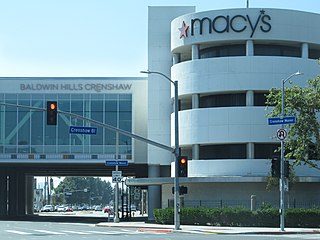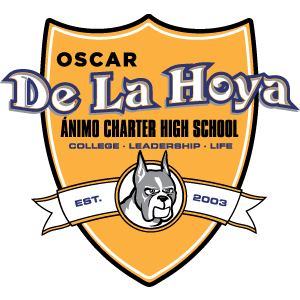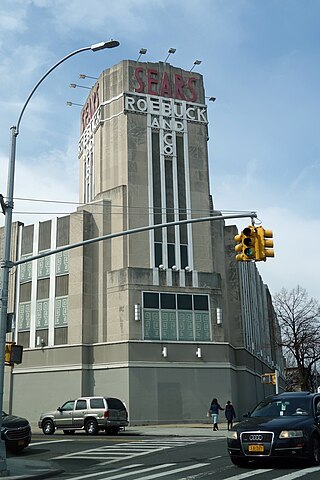
Sears, Roebuck and Co., commonly known as Sears, is an American chain of department stores founded in 1892 by Richard Warren Sears and Alvah Curtis Roebuck and reincorporated in 1906 by Richard Sears and Julius Rosenwald, with what began as a mail ordering catalog company migrating to opening retail locations in 1925, the first in Chicago. In 2005, the company was bought by the management of the American big box discount chain Kmart, which upon completion of the merger, formed Sears Holdings. Through the 1980s, Sears was the largest retailer in the United States. In 2018, it was the 31st-largest. After several years of declining sales, Sears's parent company filed for Chapter 11 bankruptcy on October 15, 2018. It announced on January 16, 2019, that it had won its bankruptcy auction, and that a reduced number of 425 stores would remain open, including 223 Sears stores.

The Eastside is an urban region in Los Angeles County, California. It includes the Los Angeles City neighborhoods east of the Los Angeles River—that is, Boyle Heights, El Sereno, and Lincoln Heights—as well as unincorporated East Los Angeles.

Ovation Hollywood is a shopping center and entertainment complex at the intersection of Hollywood Boulevard and Highland Avenue in the Hollywood neighborhood of Los Angeles, California, United States.

The Merchandise Building is a loft conversion of a former warehouse located in downtown Toronto on Dalhousie Street, near the campus of Toronto Metropolitan University and the Toronto Eaton Centre. Built in various stages from 1910 to 1949 for the Simpson's department store, and later owned by Sears Canada after Simpson's demise, the Merchandise Building at over 1,000,000 square feet (93,000 m2) is one of the largest buildings by floor area in downtown Toronto. It is an example of the early 20th-century industrial Chicago School architectural style.

The Midtown Exchange is a historic structure and mixed-use building located in the Midtown neighborhood of Minneapolis, Minnesota, United States. It is the second-largest building in Minnesota in terms of leasable space, after the Mall of America. It was built in 1928 as a retail and mail-order catalog facility for Sears, which occupied it until 1994. It lay vacant until 2005, when it was transformed into multipurpose commercial space. The building is listed on the National Register of Historic Places as the Sears, Roebuck and Company Mail-Order Warehouse and Retail Store.

May Company California was an American chain of department stores operating in Southern California and Nevada, with headquarters at its flagship Downtown Los Angeles store until 1983 when it moved them to North Hollywood. It was a subsidiary of May Department Stores and merged with May's other Southern California subsidiary, J. W. Robinson's, in 1993 to form Robinsons-May.

The Landmark Center or 401 Park Building in Boston, Massachusetts is a commercial center situated in a limestone and brick art deco building built in 1928 for Sears, Roebuck and Company. It features a 200-foot-tall (61 m) tower and, as Sears Roebuck and Company Mail Order Store, it is listed on the National Register of Historic Places and designated as a Boston Landmark in 1989.

Baldwin Hills Crenshaw Plaza is a shopping mall located in the Baldwin Hills neighborhood of Los Angeles, California. This was one of the first regional shopping centers in the United States built specifically for the automobile. Two anchor buildings, completed in 1947, retain their original Streamline Moderne style. Since the mid-1960s, the mall has become a major economic and cultural hub of surrounding African American communities which include a spectrum of socioeconomic classes.

The Sears, Roebuck and Company Complex is a building complex in the community area of North Lawndale in Chicago, Illinois. The complex hosted most of department-store chain Sears' mail order operations between 1906 and 1993, and it also served as Sears' corporate headquarters until 1973, when the Sears Tower was completed. Of its original 40-acre (16 ha) complex, only three buildings survive and have been adaptively rehabilitated to other uses. The complex was designated a National Historic Landmark in 1978, at which time it still included the 3,000,000-square-foot mail order plant, the world's largest commercial building when it was completed. That building has been demolished, its site taken up by the Homan Square redevelopment project.

Burbank Town Center is a large shopping mall and complex that opened in August 1991 in Burbank, California, with three levels of interior shopping anchored by Macy's, Burlington, Sears, and ROUND1 Bowling & Amusement, with an open-air shopping plaza anchored by Office Depot.
Sears Building is the name of a number of buildings across North America, most of which have been converted to other uses since being Sears regional headquarters, warehouses, and/or retail stores:
Soto Street is a major north-south thoroughfare in Los Angeles, California, connecting the southernmost neighborhoods of the Eastside, as well as the southeastern suburbs of Vernon and Huntington Park.
Sears, Roebuck and Company Department Store or
Sears Roebuck and Company Mail Order Store or
Sears, Roebuck & Company Mail Order Building or
Sears, Roebuck and Company Warehouse Building or variations may refer to:

Ponce City Market is a mixed-use development located in a former Sears catalogue facility in Atlanta, with national and local retail anchors, restaurants, a food hall, boutiques and offices, and residential units. It is located adjacent to the intersection of the BeltLine with Ponce de Leon Avenue in the Old Fourth Ward near Virginia Highland, Poncey-Highland and Midtown neighborhoods. The 2.1-million-square-foot (200,000 m2) building, one of the largest by volume in the Southeast United States, was used by Sears, Roebuck and Co. from 1926 to 1987 and later by the City of Atlanta as "City Hall East". The building's lot covers 16 acres (65,000 m2). Ponce City Market officially opened on August 25, 2014. It was listed on the National Register of Historic Places in 2016.
Izek Shomof is an Israeli-born, American real estate developer, investor, one-time film producer and former restaurateur. Born in Tel Aviv, he dropped out of high school to open restaurants and an autoshop. Since the 1990s, he has restored many historic buildings in Downtown Los Angeles. He has been honored for his philanthropic work in reducing homelessness in Los Angeles.
Indio Fashion Mall was a shopping mall in Indio, California, currently the site of the Indio Grand Marketplace.

Valley Plaza was a shopping center in North Hollywood, Los Angeles, one of the first in the San Fernando Valley, opened in 1951. In the mid-1950s it was reported to be the largest shopping center on the West Coast of the United States and the third-largest in the country. It was located along Laurel Canyon Boulevard from Oxnard to Vanowen, and west along Victory Boulevard. Like its competitor Panorama City Shopping Center to the north, Valley Plaza started with one core development and grew over time to market, under the single name "Valley Plaza", a collection of adjacent retail developments with multiple developers, owners, and opening dates.
Pico/Rimpau is an area of Mid-City, Los Angeles, at the junction of Pico Boulevard, Rimpau Street, San Vicente Boulevard, Venice Boulevard, Vineyard Avenue and West Boulevard. This area is the location of several key former and current transportation hubs and retail shopping centers for the Los Angeles area.

Oscar De La Hoya Ánimo Charter High School is a public high school operated by Green Dot Public Schools of Los Angeles. The school began operating in 2003 at another site while construction of the school was happening on the former site of his gym, with the building opening in 2009.

The Sears Roebuck & Company Department Store is a landmarked former department store in the Flatbush neighborhood of Brooklyn, New York City.




















